Drilling Muds
A water-base drilling fluid is one that has water as its continuous or liquid phase. The types of drilling fluids are briefly described in the following lines.
Freshwater muds are generally lightly treated or untreated muds having a liquid phase of water, containing small concentrations of salt, and having a pH ranging from 8.0 to 10.5.
Oil-Base Muds differs from water base muds, Fresh water muds include the following types.
Spud Muds These muds are prepared with available water and appropriate concentrations of bentonite and/or premium commercial clays. They are generally untreated chemically, although lime, cement, or caustic soda is occasionally added to increase viscosity and give the mud a fluff to seal possible lost return zones in unconsolidated upper hole surface formations.
Spud muds are used for drilling the surface hole. Their tolerance for drilled solids and contaminants is very limited.
Natural Mud Natural or native muds use native drilled solids incorporated into the mud for viscosity, weight, and fluid loss control. They are often supplemented with bentonite for added stability and water loss control. Surfactants can be used to aid in controlling mud weight and solids buildup. Natural muds are generally used in top hole drilling to mud-up or to conversion depth. They have a low tolerance for solids and contamination.
Saltwater Muds Muds ordinarily are classified as saltwater muds when they contain more than 10,000 mg/L of chloride. They may be further classified according to the amount of salt present and/or the source of makeup water (see Table below):
Amount of chloride in mg/L
- Saturated salt muds (315,000ppm as sodium chloride)
- Salt muds (over 10,000 mg/L chloride but not saturated) Source of make-up water
- Brackish water
- Sea Water
Saltwater muds may be purposely prepared, or they may result from the use of salty makeup water, from drilling into salt domes or stringers, or when saltwater flows are encountered. Saltwater muds include the following types.
Seawater or Brackish Water Muds These muds are prepared with available makeup water, both commercial and formation clay solids, caustic soda, and lignite and/or a lignosulfonate. CMC is usually used for fluid loss control, although concentration of lignites and lignosulfonates are also often used for this purpose. Viscosity and gel strength are controlled with caustic soda, lignosulfonate, and/or lignites. Soda ash is frequently used to lower the calcium concentration. CMC or lignosulfonates are used for water loss control, and pH is controlled between 8.5 to 11.0 with caustic
soda. Seawater muds and brackish or hard water muds are used primarily because of the convenience of makeup water, usually open sea or bays. The degree of inhibitive properties varies with the salt and calcium concentration in the formulated fluid.
Saturated Salt Muds Saturated salt water (natural or prepared) is used as makeup water in these fluids. Prehydrated bentonite (hydrated in freshwater) is added to give viscosity, and starch is commonly used to control fluid loss. Caustic soda is added to adjust the pH, and lignosulfonates are used for gel strength control. Occasionally, soda ash may be used to lower filtrate calcium and adjust the pH. Saturated salt muds are used to drill massive salt sections (composed mainly of NaCl) to prevent washouts and as a work-over or completion fluid. Freshwater bentonite suspensions are converted by adding NaCl to reach saturation. Conversion is carried out by diluting the freshwater mud to reduce the viscosity “hump” seen in breakovers. Saturated salt muds usually are used at mud weights below 14.0 lb/gal.
Composition of NaCl mud
- Brine NaCl
- Density —salt, barite, calcium carbonate or hematite
- Viscosity — CMC HV, Prehydrated bentonite, XC-polymer (xanthan gum)
- Rheology—lignosulfonate
- Fluid Loss—CMC LV or PAC (polyanionic cellulose)
- pH – Pf (alkalinity) —caustic potash or caustic soda
Chemically Treated Mud (No Calcium Compounds) This type of mud is made up of a natural mud that has been conditioned with bentonite and treated with caustic soda and lignite or lignosulfonate (organic thinner). No inhibiting ions are found in this type of fluid.
Lignite/Lignosulfonate Mud This fluid is prepared from fresh water and conditioned with bentonite. Lignosulfonate is added as a thinner and lignite for filtration control and increased temperature stability. CMC or PAC may be used for additional filtration control when the bottom-hole temperature does not exceed 121◦C (250◦F). This type of mud is applied at all mud weights and provides a relatively low pH system (pH values for calcium lignosulfonates will be 10.0–11.0). This type of fluid is stable at reasonably high temperatures (325◦F) and has good resistance to contamination.
Calcium Treated Muds Calcium-treated fluids are prepared from any low or high pH mud by the addition of appropriate amounts of lime or gypsum, caustic soda, and thinner (lignite or lignosulfonate). Calcium-treated drilling muds include lime and gypsum drilling muds.
Lime Muds Lime muds include low- and high-lime muds. They are prepared from available drilling muds by adding calcium lignosulfonate, lignite, caustic soda or KOH, lime, and a filtration-control material, PAC or starch. Caustic soda is used to maintain the filtrate alkalinity (Pf values) and lime to control the mud alkalinity (Pm values) and excess lime. Lime drilling muds offer resistance to salt, cement, or anhydrite contamination even at high mud weights.
Gypsum Mud Commonly called “gyp muds,” they are prepared from freshwater and conditioned with bentonite or from available gel and water mud. Caustic soda is added for pH control. Gypsum, lignosulfonate, and additional caustic soda are added simultaneously to the mud. CMC may be added for filtration control. This fluid is used for drilling in mildly reactive shale or where gypsum or anhydrite must be drilled. It resists contamination from cement or salt. Use is limited by the temperature stability of the filtration control materials, CMC (250◦F ±).

